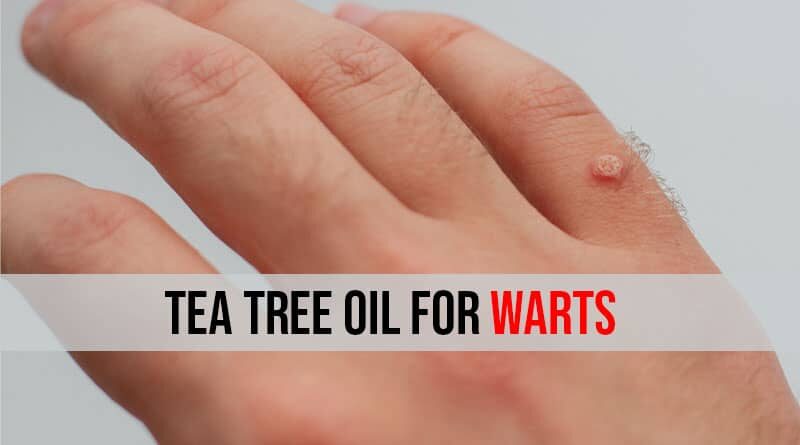Tea Tree Oil for Warts: Benefits, How to Use, and Remedies
Warts are small, rough growths on the skin caused by the human papillomavirus (HPV). While warts are not life-threatening, they can be painful, bothersome, and contagious. Many people look for natural remedies to treat warts, and tea tree oil is a popular option due to its antiviral, antimicrobial, and immune-boosting properties.
Table of Contents
Is Tea Tree Oil Good for Warts?
Yes! Tea tree oil is an essential oil with potent antiviral properties that may help eliminate warts by attacking the virus and preventing its spread. Studies have shown that tea tree oil can be effective against various pathogens, including HPV.
Benefits of Tea Tree Oil for Warts
Antiviral Properties
Tea tree oil contains compounds like terpinen-4-ol, which have been shown to fight viruses, including HPV.
A 2001 study found that a combination of tea tree oil and eucalyptus oil was effective against herpes simplex virus (HSV), a virus similar in structure to HPV.
Boosts Immunity
Tea tree oil may help stimulate the immune response, encouraging the body to fight off the wart-causing virus.
Research suggests that applying tea tree oil directly to warts may help activate white blood cells, which play a crucial role in fighting infections.
Prevents Infection & Spreading
Tea tree oil’s antimicrobial and antiseptic properties help keep the affected area clean.
Regular application can reduce the risk of spreading warts to other parts of the body or other people.
How to Use Tea Tree Oil for Warts
Tea tree oil should be used carefully to prevent skin irritation. Here are proven methods to use tea tree oil for warts effectively:
1. Direct Application (Undiluted for Stubborn Warts)
Apply 1–2 drops of 100% tea tree oil directly to the wart using a cotton swab.
Cover with a bandage and leave it overnight.
Repeat daily until the wart disappears (typically 4–6 weeks).
2. Tea Tree Oil for Genital Warts (Dilution Required!)
Genital warts are sensitive, so dilute tea tree oil before application:
Mix 1 drop of tea tree oil with 5 drops of coconut oil.
Apply gently using a cotton swab.
Do not use internally; consult a doctor before using for genital warts.
3. Tea Tree Oil & Eucalyptus Oil
Mix 1 part tea tree oil with 1 part eucalyptus oil.
Apply to the wart using a cotton ball and cover it overnight.
Repeat daily until the wart shrinks.
4. Tea Tree Oil & Sandalwood Oil
Mix equal parts tea tree oil and sandalwood oil.
Studies suggest that sandalwood oil can help treat warts in 80% of cases.
Apply twice daily and continue for 10–12 weeks.
5. Tea Tree Oil & Salicylic Acid (For Faster Results)
Salicylic acid is a clinically approved wart treatment.
Add a few drops of tea tree oil to an over-the-counter salicylic acid cream.
Apply once daily and continue for 4–6 weeks.
6. Apple Cider Vinegar & Tea Tree Oil
Mix 1 drop of tea tree oil, 1 drop of ACV, and 2 drops of water.
Apply directly to the wart and cover with a bandage.
Leave it overnight and repeat daily.
7. Baking Soda & Tea Tree Oil
Baking soda absorbs moisture, making it hard for the virus to survive.
Mix 1 tbsp baking soda, 8 drops of tea tree oil, and ½ cup water.
Apply with a cotton ball and leave it for a few hours.
Do this twice daily for better results.
8. Garlic & Tea Tree Oil (Strong Antiviral Combo!)
Crush a small garlic clove and mix with 2–3 drops of tea tree oil.
Apply the mixture to the wart and cover with a bandage.
Let it sit for a few hours, then rinse off.
Repeat daily until the wart disappears.
9. Coconut Oil & Tea Tree Oil (Best for Sensitive Skin)
Mix 1 drop of tea tree oil with 1 tsp of coconut oil.
Apply to the wart twice a day.
This method is gentle on sensitive skin while still fighting the virus.
Precautions & Side Effects
Tea tree oil is potent! Always perform a patch test before use.
Avoid using undiluted tea tree oil on genital warts.
If irritation, redness, or a burning sensation occurs, stop use immediately.
Do not ingest tea tree oil—it is toxic when swallowed.
Consult a dermatologist if warts persist or worsen.
Frequently Asked Questions (FAQs)
1. How long does tea tree oil take to remove warts?
It varies based on the wart’s size and location. Most warts start shrinking within 4–6 weeks of daily application.
2. Can I use tea tree oil on genital warts?
Yes, but always dilute it with coconut oil to avoid irritation. Never apply internally or to sensitive mucous membranes.
3. Is tea tree oil safe for children?
Tea tree oil can be used for warts on children, but it must be diluted with a carrier oil like coconut or olive oil. Consult a pediatrician before use.
4. Can I mix tea tree oil with other treatments?
Yes, it works well with salicylic acid, apple cider vinegar, and essential oils like eucalyptus or sandalwood oil.
5. What if my wart doesn’t go away?
If the wart persists after 8–12 weeks, consult a dermatologist for alternative treatments like cryotherapy or laser removal.
Conclusion
Tea tree oil for warts is a natural, effective remedy that works by fighting the virus, boosting immunity, and preventing infections. Whether used alone or combined with other natural ingredients like apple cider vinegar, salicylic acid, or essential oils, tea tree oil is a powerful tool against warts.
However, persistent or painful warts should be evaluated by a dermatologist for proper medical advice.
References:
Recommended Articles:
Tea Tree Oil for Burns Treatment




